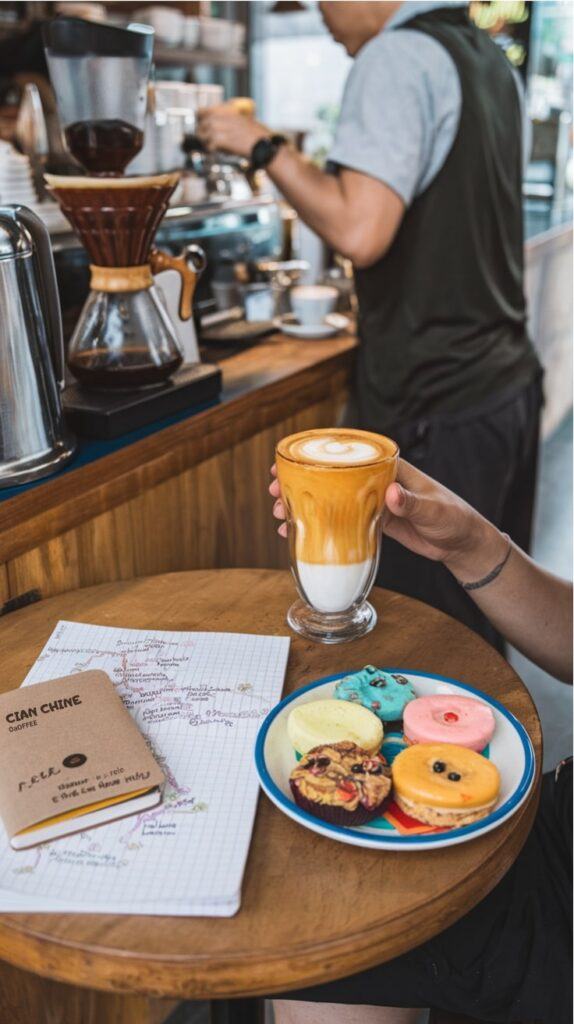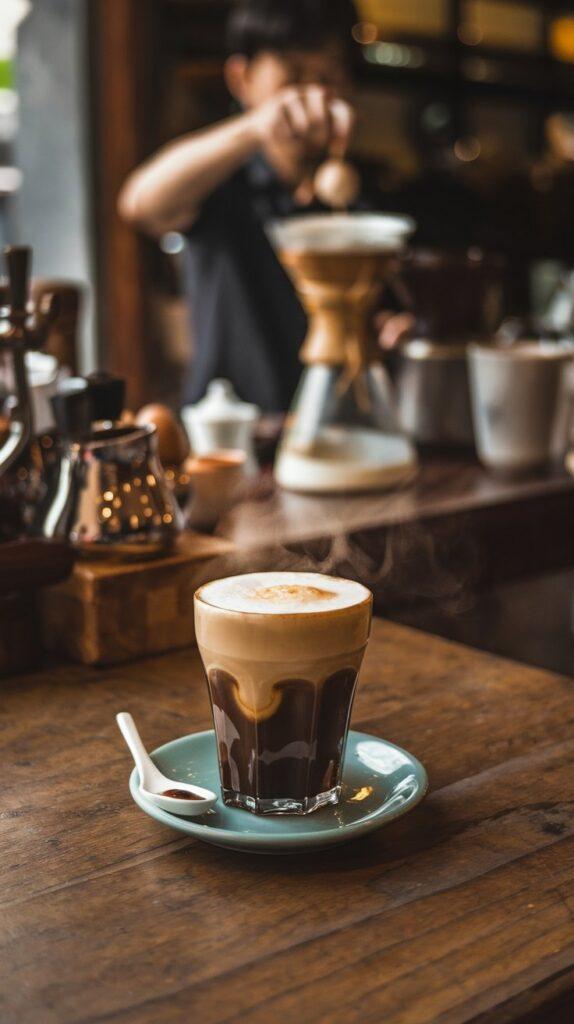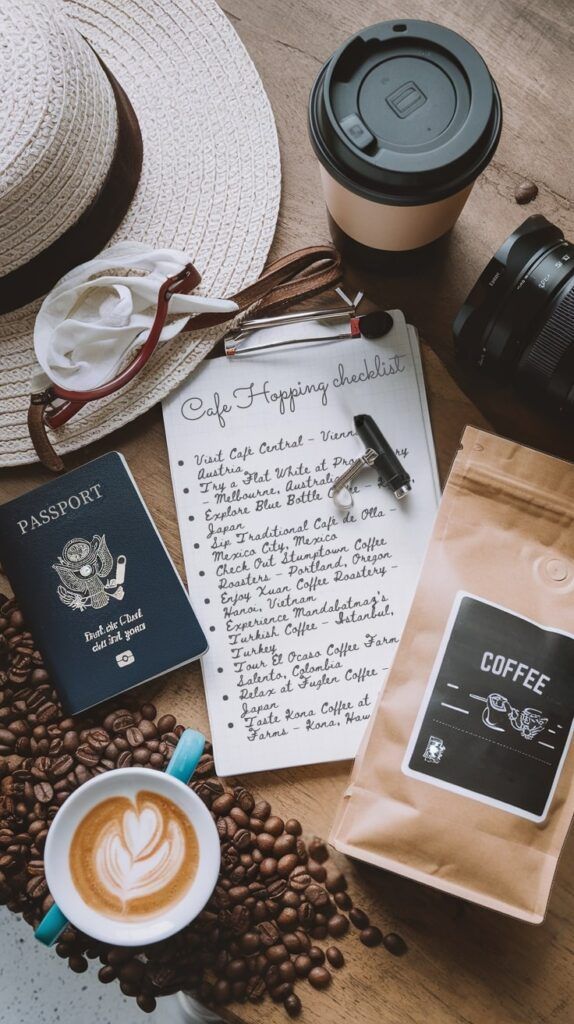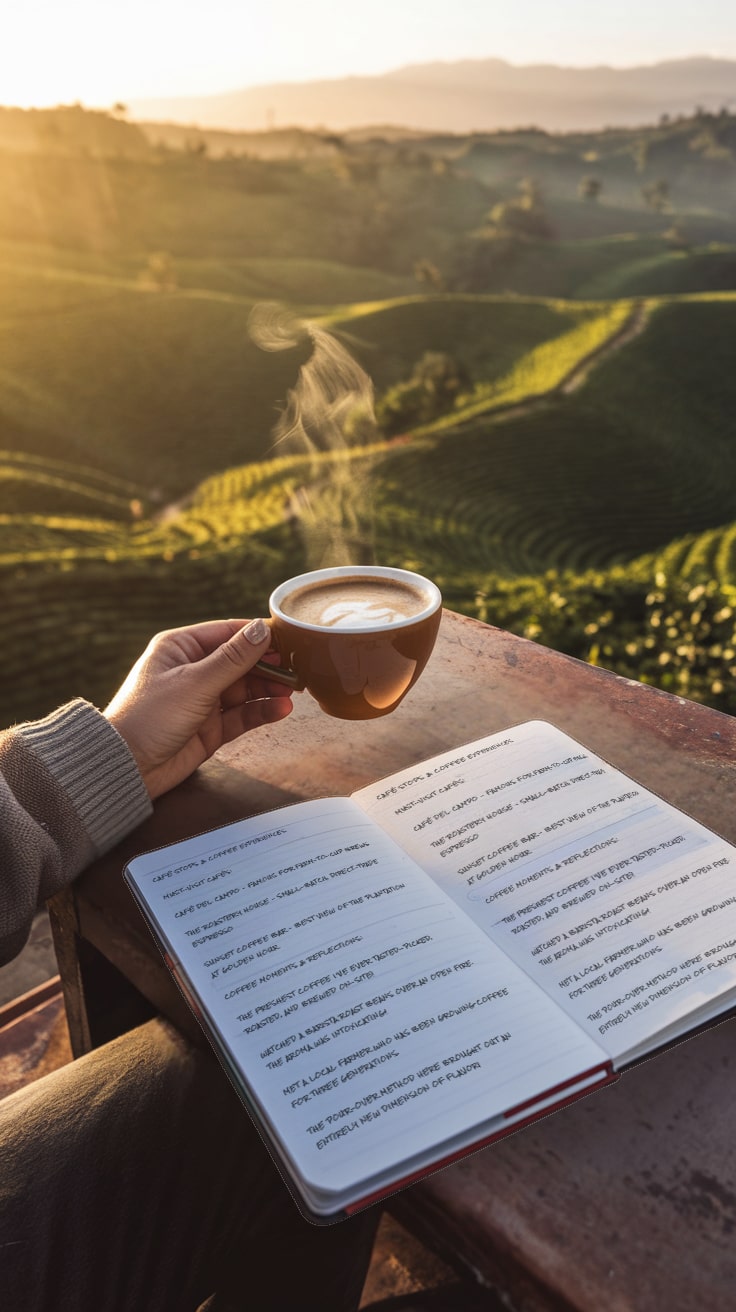For most people, coffee is simply part of their daily routine, a necessary wake-up call, a moment of comfort, or an afternoon pick-me-up. But for others, coffee is far more than just a drink; it’s a passion, a culture, and even a reason to travel.
Coffee tourism offers a unique blend of experiences where every sip tells a story. It’s about discovering the rich histories, rituals, and craftsmanship behind the world’s most beloved beverage. Whether you’re wandering through historic cafés in Vienna, exploring lush coffee plantations in Costa Rica, or attending a world-class barista competition, coffee tourism transforms a simple cup into a memorable adventure.
But what exactly is coffee tourism, and how can you turn your love for coffee into a journey of exploration?
In this guide, we’ll uncover:
- There are different ways coffee lovers can explore the world through coffee.
- The best destinations for coffee tourism, from origin farms to iconic cafés.
- How to plan your own coffee-themed trip, whether it’s a weekend café crawl or an immersive farm stay.
Grab your favorite brew, and let’s dive into the world of coffee tourism!
What Exactly is Coffee Tourism?
If you think coffee tourism just means visiting cafés in different cities, you’re only scratching the surface.
At its core, coffee tourism is about immersing yourself in the coffee culture of a destination. It can mean exploring historic coffeehouses in Vienna, witnessing the coffee production process in Ethiopia, or attending international coffee festivals where the best baristas in the world compete.
Why Coffee Tourism is Growing
More travelers are seeking authentic, experience-based trips, and coffee offers a perfect blend of:
- Cultural immersion – Learning about traditions, rituals, and the social role of coffee in different parts of the world.
- Hands-on experiences – Visiting farms, participating in coffee tastings, or learning brewing techniques from local baristas.
- Sustainability awareness – Understanding where coffee comes from, how it’s grown, and its impact on farming communities.
Different Forms of Coffee Tourism
Coffee tourism is incredibly diverse. Here are some ways travelers experience it:
- Self-Guided Café Hopping – Creating an itinerary of must-visit specialty coffee shops.
- Coffee Farm Stays – Living and working on a coffee plantation for a deeper connection to the process.
- Roastery Visits – Watching beans go from green to roasted perfection in a professional setting.
- Cultural Coffee Experiences – Participating in Turkish coffee ceremonies or Japanese siphon brewing classes.
- Coffee Competitions & Events – Watching world-class baristas compete in latte art throwdowns or brewing championships.
Coffee isn’t just a beverage; it’s a gateway to understanding different cultures, economies, and even global sustainability efforts.
Must-Try Coffee Experiences for Travelers
Coffee tourism isn’t just about finding a great cup of coffee; it’s about immersing yourself in the culture, history, and craftsmanship behind every sip. Whether you want to wander through third-wave coffee shops, attend a world-class coffee festival, or harvest beans at a coffee farm, there’s a coffee experience tailored for every kind of traveler.
Here are some of the top ways to experience coffee while traveling.
1. Café Hopping: Exploring the Heart of Local Coffee Scenes
There’s something magical about discovering a city’s coffee culture through its cafés. From elegant historic coffeehouses to sleek, minimalist third-wave cafés, each destination has a distinct coffee identity.
Best Café-Hopping Cities:
- Melbourne, Australia – A third-wave coffee mecca with precisely brewed pour-overs and flat whites.
- Portland, Oregon – Quirky, craft-focused, and home to some of the best micro-roasters in the U.S., Discover the vibrant coffee scene in Portland, known for its unique cafés and signature drinks, in our comprehensive guide.
- Vienna, Austria – A city where coffeehouses feel more like luxurious salons from the 19th century.
- Istanbul, Turkey – Where strong, unfiltered Turkish coffee is served in ornate cups, often with fortune-telling rituals.
Pro tip: If you want a self-guided coffee tour, research specialty coffee trails in major cities; many third-wave coffee destinations have curated café maps.
2. Coffee Festivals & Events: Where the Best Baristas Shine
For those who want to see the cutting edge of coffee innovation, coffee festivals and industry competitions are a must. These events bring together the world’s best baristas, roasters, and coffee scientists to showcase new techniques, gear, and flavors.
Top Coffee Events Around the World:
- World Barista Championship (Rotating Locations) – The Olympics of coffee, where the best baristas compete for the world title.
- Milan Coffee Festival (Italy) – A fusion of espresso culture, latte art throwdowns, and tasting sessions.
- Seattle Coffee Fest (USA) – A hotspot for discovering indie roasters, new brewing equipment, and emerging trends.
- Tokyo Coffee Festival (Japan) – A celebration of meticulous brewing techniques and Japanese coffee precision.
If you’re serious about learning the latest trends and innovations in coffee, festivals are the perfect opportunity to sip, learn, and network with industry experts.
3. Visiting Coffee Farms: The Ultimate Origin Experience
Want to see coffee at its source? Farm visits give travelers an up-close look at the bean-to-cup process, from picking cherries off coffee trees to watching beans dry in the sun. For a deeper understanding of what to expect during a coffee farm visit, including the harvesting and processing stages, check out our detailed guide.
Best Places for Coffee Farm Stays:
- Colombia’s Coffee Triangle – Stay at a hacienda and learn about high-altitude Arabica production.
- Costa Rica’s Tarrazú Region – Discover eco-friendly coffee farms with sustainable practices.
- Ethiopia’s Sidamo & Yirgacheffe – Witness traditional Ethiopian coffee processing and ceremonies.
- Hawaii’s Kona Coast – See volcanic soil-grown coffee farms with unique microclimates.
Want to see what a hands-on coffee tour in Costa Rica looks like? Experience the journey from bean to cup with this behind-the-scenes look at a Costa Rican coffee farm:
Farm tours are perfect for sustainability-conscious travelers who want to understand the challenges of ethical coffee production. Some farms even offer multi-day stays, where visitors can work alongside farmers, help with harvesting, and roast their own beans.
4. Cultural Coffee Rituals: A Taste of Tradition
Some places have centuries-old coffee traditions that are deeply woven into the local culture. These experiences go beyond just drinking coffee; they offer a window into history, hospitality, and community.
Fascinating Coffee Traditions to Experience:
- Ethiopian Coffee Ceremony – A spiritual and communal coffee ritual, where beans are roasted, ground, and brewed in a jebena (traditional clay pot).
- Turkish Coffee & Fortune Telling – A strong, unfiltered coffee brewed in a cezve over an open flame, with the grounds used for fortune reading.
- Vietnamese Egg Coffee – A rich, creamy coffee made with whipped egg yolks, a unique specialty from Hanoi.
- Italian Espresso Culture – Ordering an espresso “al banco” (standing at the bar) like a true Italian.
Each tradition offers a deeper appreciation for coffee’s role in different cultures, connecting people through ritual and craftsmanship.
5. Unique Coffee & Food Pairings: Elevate Your Tasting Experience
Pairing coffee with the right flavors can transform your tasting experience. Certain foods enhance the natural notes of coffee, creating unexpected and delightful combinations.
Coffee & Food Pairing Ideas:
- Italy: Espresso & biscotti – A crunchy almond biscotti perfectly complements the rich bitterness of espresso.
- France: Café au lait & croissant – A buttery, flaky croissant dipped in creamy café au lait.
- Mexico: Café de olla & cinnamon pastries – A traditional spiced coffee sweetened with piloncillo, paired with pan dulce.
- Japan: Pour-over coffee & wagashi – Delicate Japanese sweets enhance floral and tea-like coffee notes.
For coffee lovers who appreciate flavor complexity, these pairings take the experience to a whole new level.
Best Destinations for Coffee Tourism
If coffee tourism is your idea of the perfect getaway, you’re in luck. Some cities and regions around the world live and breathe coffee culture, offering everything from historic cafés to high-tech roasteries and immersive farm experiences.
No matter what kind of coffee traveler you are, whether you love a well-pulled espresso in a grand café or want to walk the fields where coffee is grown, these destinations are a must-visit.
For Café Culture Lovers: Cities with Iconic Coffee Scenes
If your perfect trip includes wandering through atmospheric coffeehouses, sipping beautifully crafted drinks, and soaking in the local café culture, these destinations belong on your list.
Vienna, Austria – A Coffeehouse Time Capsule
- Step inside Café Central or Café Sperl, where marble-topped tables and chandeliers create an old-world charm.
- Order a Wiener Melange, Vienna’s signature coffee, topped with steamed milk and froth.
- Experience coffeehouse culture as UNESCO heritage, where cafés serve as intellectual and artistic meeting points.
Istanbul, Turkey – Where Coffee is an Art Form
- Watch Turkish coffee brewed in a cezve over sand, an ancient method passed down through generations.
- Sip strong, unfiltered coffee served with sweet lokum (Turkish delight).
- Visit historic spots like Mandabatmaz, where thick, foamy Turkish coffee is a local legend.
Melbourne, Australia – The Third-Wave Coffee Capital
- Known for world-class baristas and obsessive attention to espresso quality, Melbourne’s coffee culture is a must-experience destination for coffee lovers who appreciate craftsmanship and innovation in every cup.
- Visit specialty cafés like Proud Mary, Market Lane, and Patricia Coffee Brewers.
- Try the flat white, a Melbourne-born coffee drink loved worldwide.
Seattle, USA – The Birthplace of American Coffee Culture
- Home to big names like Starbucks, but also an indie specialty coffee scene.
- Tour micro-roasteries like Victrola Coffee Roasters and Elm Coffee.
- Experience a coffee-tasting flight in one of the city’s high-end cupping labs.
For Coffee Farm Adventurers: Where Coffee is Grown
If you want to see coffee at its source, visit these coffee-producing regions where you can tour farms, meet growers, and taste beans fresh from harvest.
Colombia – The Coffee Triangle
- Visit Hacienda Venecia or Finca El Ocaso for a full farm-to-cup experience.
- Learn how altitude and climate affect coffee flavor.
- Stay at a traditional hacienda surrounded by coffee plants.
Colombia is home to some of the most breathtaking coffee landscapes and traditional farming communities.
Watch this video for a glimpse into Colombia’s coffee region, from charming coffee towns to local farms and the people behind the beans:
Ethiopia – The Birthplace of Coffee
- Walk through the lush forests of Yirgacheffe, where coffee grows wild.
- Witness a traditional Ethiopian coffee ceremony, where beans are roasted, ground, and brewed fresh.
- Visit smallholder farms that still cultivate coffee the way it’s been done for centuries.
Costa Rica – Sustainability & Eco-Farms
- Discover shade-grown, organic coffee farms in the Tarrazú region.
- Learn about sustainable coffee production at Café Britt or Doka Estate.
- Stay on a working coffee farm for a hands-on experience.
Hawaii – Volcanic Soil, Distinctive Flavor
- Visit Kona coffee farms, where beans thrive in rich volcanic soil.
- Tour small family-owned estates and taste unique island-grown coffee.
- Enjoy a coffee and chocolate pairing session at Greenwell Farms.
For Specialty Coffee Lovers: Innovation & Roastery Culture
Some cities are pushing the boundaries of coffee science and roasting, making them perfect for travelers who love high-end specialty coffee.
Portland, Oregon – The Indie Roaster Hub
- Visit Coava, Heart, and Stumptown Coffee Roasters for some of the best small-batch coffee in the U.S.
- Take a roasting workshop and learn how different profiles bring out unique flavors.
- Try a coffee tasting flight at a brew bar, where baristas experiment with alternative extraction methods.
Tokyo, Japan – Precision Meets Coffee Artistry
- Experience hyper-precise pour-overs at places like Koffee Mameya and Fuglen Tokyo.
- Explore Japanese siphon coffee brewing, a mesmerizing slow-extraction process.
- Visit a specialty roastery where coffee beans are selected with meticulous care.
Mexico City, Mexico – A Rising Coffee Star
- Take a farm tour in Chiapas or Oaxaca to see where Mexico’s top coffee is grown.
- Discover a thriving specialty coffee scene blending traditional and modern techniques.
- Visit cafés like Buna, Casa Cardinal, and Borola, where Mexican-grown beans take center stage.
Ethical & Sustainable Coffee Tourism: Traveling with a Purpose
Coffee is more than just a drink—it’s a global industry that supports millions of farmers, roasters, and baristas worldwide. But not all coffee is produced under fair conditions. As coffee tourism grows, so does the responsibility to travel ethically, support sustainable farms, and make conscious coffee choices.
Whether you’re visiting a coffee plantation in Colombia or sipping a carefully crafted pour-over in Tokyo, here’s how you can be a responsible coffee traveler.
1. Choose Coffee Farms with Ethical Practices
Not all coffee farms operate under fair conditions. Some rely on exploitative labor, low wages, or environmentally harmful practices. To ensure your visit supports the right kind of coffee production, look for farms that:
- Practice fair trade or direct trade – Ensuring farmers get paid fairly for their beans.
- Use sustainable farming methods – Shade-grown coffee, organic cultivation, or water-saving processing.
- Prioritize worker well-being – Providing fair wages, education programs, or community support.
- Encourage biodiversity – Farms that protect natural ecosystems instead of clear-cutting forests for coffee plantations.
Best destinations for ethical coffee farm tours:
- Costa Rica’s Tarrazú region – A hub for eco-friendly coffee farms.
- Ethiopia’s Yirgacheffe & Sidamo regions – Smallholder farms with generations of coffee-growing tradition.
- Colombia’s Finca La Palma y El Tucán – A farm dedicated to sustainable practices and direct-trade relationships.
When booking a coffee tour, check if the farm has certifications like Rainforest Alliance, Fair Trade, or Bird-Friendly Coffee, but also remember that some small farms practice sustainability without formal certifications.
2. Support Local Coffee Roasters & Independent Cafés
When traveling, it’s tempting to stop by familiar coffee chains, but part of ethical coffee tourism is supporting local businesses.
Instead of grabbing a latte at a big-name multinational brand, seek out:
- Independent specialty coffee shops that source beans directly from ethical farms.
- Local micro-roasters that work with sustainable coffee producers.
- Cafés that promote transparency, listing the origin and farmer behind each cup.
In cities like Melbourne, Portland, and Mexico City, independent cafés are at the heart of the coffee culture. Spending your coffee dollars locally helps sustain small businesses and fosters a global specialty coffee movement.
3. Be a Conscious Coffee Consumer: Ask Questions
A simple way to travel responsibly? Ask questions before you buy your coffee.
Next time you step into a café or roastery, consider asking:
- Where do you source your beans? – A good café should know the farm or region.
- Do you work directly with farmers? – Direct-trade coffee ensures fairer wages.
- How is the coffee processed? – Some methods, like washed processing, use large amounts of water, while natural processing is more eco-friendly.
Even if you’re just ordering a cappuccino in a new city, these small actions help promote transparency and ethical sourcing in the coffee industry.
4. Reduce Waste: Ditch Single-Use Cups & Plastics
Coffee tourism should be sustainable, not wasteful.
As you travel, try to:
- Bring a reusable coffee cup – Many cafés now offer discounts for reusable cups.
- Skip plastic lids & straws – Go lidless or bring a reusable alternative.
- Buy coffee beans in bulk – Instead of single-use packaging, look for cafés that offer refillable coffee tins or compostable bags.
Some of the best eco-conscious cafés and roasters have already embraced zero-waste coffee packaging, including:
- Blue Bottle Coffee (USA & Japan) – Compostable coffee bags & reusable tins.
- Allpress Espresso (Australia & UK) – Sustainable coffee packaging & cup-free cafés.
- Buna Café (Mexico City) – Focused on eliminating plastic waste in coffee service.
5. Experience Coffee Without Harming the Environment
Some of the world’s most beautiful coffee-growing regions, Colombia’s mountains, Costa Rica’s rainforests, and Ethiopia’s highlands, are also fragile ecosystems. Coffee tourism can have an environmental impact, but you can minimize yours by:
- Choosing eco-certified tours that respect local biodiversity.
- Avoid mass tourism coffee tours that prioritize profits over sustainability.
- Respecting water and energy usage, some coffee farms struggle with droughts, so be mindful of water use during your visit.
- Buying locally roasted coffee instead of airport souvenirs supports local businesses instead of mass-produced, low-quality coffee.
When visiting coffee farms, be aware of your footprint. Stick to designated trails, don’t pick unripe cherries unless invited to, and follow sustainable tourism guidelines.
How to Plan the Perfect Coffee-Themed Trip
Dreaming of a coffee-fueled adventure? Whether you’re planning a weekend café crawl in a specialty coffee city or a full-on origin trip to a coffee farm, a little preparation can turn your trip into an unforgettable experience.
Here’s how to plan the perfect coffee-themed getaway that’s both immersive and rewarding.
1. Choose Your Coffee Destination: What Kind of Experience Do You Want?
Before booking your ticket, ask yourself: What do I want out of this trip?
- For café-hopping & specialty coffee culture: Head to Melbourne, Portland, or Tokyo for some of the best third-wave coffee experiences.
- For historic coffee traditions & rituals: Visit Vienna for elegant coffeehouses, Istanbul for Turkish coffee culture, or Rome for espresso etiquette.
- For farm-to-cup experiences: Explore the coffee-growing regions of Colombia, Costa Rica, or Ethiopia to see how coffee is grown, harvested, and processed.
- For coffee events & education: Attend Seattle Coffee Fest, Milan Coffee Festival, or the World Barista Championship to dive deep into coffee craftsmanship.
2. Plan Your Coffee Itinerary: Mix Structured & Free Exploration
A great coffee trip balances planned experiences and spontaneous discoveries.
- Guided Coffee Experiences: Book a coffee tour or farm visit in advance, especially for remote locations where tours fill up fast.
- Self-Guided Café Hopping: Research must-visit specialty coffee shops and create a flexible itinerary. Leave room for hidden gems you might stumble upon.
- Coffee Education Stops: Look for roastery tours, barista workshops, or cupping sessions to level up your coffee knowledge.
- Local Coffee Festivals: Check event calendars to see if a coffee festival or competition aligns with your travel dates.
Example itinerary for a coffee weekend in Melbourne:
- Morning: Espresso and pastries at Market Lane Coffee.
- Midday: Roastery tour at Industry Beans, followed by a cupping session.
- Afternoon: Explore hidden laneway cafés like Brother Baba Budan.
- Evening: Sunset coffee cocktail at a specialty bar.
3. Travel Like a Coffee Pro: Essential Packing List
Every great coffee traveler comes prepared! Here’s what to pack for a smooth, caffeine-filled adventure:
- Reusable Coffee Cup – Many specialty cafés offer discounts for bringing your own.
- Notebook or Coffee Journal – Take notes on flavors, brewing methods, and café recommendations.
- Portable Coffee Kit – If you can’t live without your own brew, pack an AeroPress or a collapsible pour-over dripper.
- Filtered Water Bottle – Great coffee starts with great water, and this helps reduce plastic waste.
- Local Coffee Guidebook or Café Map – Some coffee-centric cities have printed coffee trails to follow.
4. Capture & Share Your Coffee Journey
Want to document your coffee travels like a pro? Here’s how to make the most of your experiences:
Photography Tips:
- Capture latte art from above for that classic Instagram shot.
- Focus on details, the swirl of espresso in a demitasse, the steam rising from a fresh pour-over.
- Don’t forget environmental shots, your coffee cup with a stunning view, the barista in action, or the café’s unique décor.
Write About Your Experience:
- Keep a coffee journal where you jot down your favorite cafés, brewing techniques, and tasting notes.
- Write reviews on Google Maps or specialty coffee blogs to support local businesses.
Engage with the Coffee Community:
- Share your finds with #CoffeeTravel or local hashtags.
- Ask baristas for recommendations; many of the best coffee spots are word-of-mouth secrets!
5. Bring the Coffee Experience Home
A coffee trip doesn’t have to end when you board your flight home. Here’s how to keep the adventure going:
- Bring back local beans – Buy whole beans from a roaster you loved on your trip.
- Learn a new brewing method – If you picked up a Turkish cezve in Istanbul or a siphon brewer in Tokyo, perfecting the technique at home keeps the travel memories alive.
- Subscribe to a coffee roaster from your favorite city – Many specialty coffee shops ship worldwide, so you can continue enjoying their beans long after your trip.
Final Thoughts — Turning Every Sip into a Story
Coffee tourism is more than just drinking coffee in different places; it’s about immersing yourself in the culture, history, and craftsmanship that make each cup unique. Whether you’re savoring a café au lait in a Parisian coffeehouse, participating in an Ethiopian coffee ceremony, or standing on a coffee farm surrounded by the aroma of freshly roasted beans, every destination has a story to tell through coffee.
By now, you’ve explored:
- What coffee tourism is and how it transforms the way we experience coffee.
- The best destinations for discovering coffee culture, from Vienna’s elegant cafés to Colombia’s high-altitude farms.
- How to travel ethically and support sustainable coffee practices.
- Tips for planning your own coffee-themed adventure, whether it’s a short getaway or a deep dive into coffee origins.
If you’re inspired to explore coffee tourism further, take a deep dive into Vienna’s Coffee House Culture, where elegant coffeehouses and rich traditions make every cup a journey through history. Discover the iconic cafés, timeless rituals, and cultural significance that have made Vienna a legendary coffee destination.
What about you? Have you ever traveled for coffee or dreamt of visiting a specific coffee destination? Share your thoughts, favorite spots, or questions in the comments below. We’d love to hear your coffee stories!
Save this post for later! Planning a trip soon? Pin this guide to your Coffee Travel board so you’ll have it handy when it’s time to explore.








Wow—as a coffee lover, I know I’m going to love your site! Thanks for this informative article about coffee tourism. I can honestly say it’s not something I had really thought about before, but now that you mention it, I love the idea.
I think I’ll have to start small by exploring my local coffee shops, then expand to different towns and eventually new regions. South America is high on my list, and what better excuse to visit than to experience their incredible coffee firsthand?!
One question I have is about safety. I know tourists can sometimes be targets in certain countries, so what’s your opinion on the safety of coffee tourism in the destinations you mentioned?
I love your enthusiasm for coffee tourism! Exploring local coffee shops is a great approach—it helps build an appreciation for different brewing styles and beans before diving into international coffee adventures. South America is a fantastic choice for coffee lovers. The coffee culture in places like Colombia, Brazil, and Peru is incredible, with farms offering hands-on experiences that bring you right into the heart of coffee production.
Regarding safety concerns, it’s a valid point and something every traveler should consider. The good news is that many well-known coffee regions are quite safe, especially if you stick to established tours and well-reviewed farms. For example, Colombia’s Coffee Triangle (Salento, Manizales, Armenia) is a top destination with a strong tourism infrastructure and guided tours that prioritize visitor safety. Costa Rica is another great option, known for its welcoming locals and eco-friendly coffee farms.
Here are a few general safety tips for coffee tourism:
✔ Book tours through reputable companies – They have local expertise and ensure safe experiences.
✔ Stay aware of your surroundings – Like any travel destination, sticking to well-traveled areas is best.
✔ Research specific regions – Some countries have coffee-growing areas that are safer than others, so it’s always good to check current travel advisories.
Do you have a specific South American destination in mind? I’d love to hear where you’re thinking of visiting!
Happy coffee travels!
I love this deep dive into coffee tourism! It’s fascinating how coffee can be more than just a drink—it becomes a cultural experience and even a reason to travel.
I’ve always been curious about visiting a coffee farm in Costa Rica to see the bean-to-cup process firsthand. I once did a self-guided café tour in Portland, Oregon, and it completely changed the way I appreciate coffee.
The focus on sustainability and ethical practices mentioned here is also super important. It’s inspiring to see how we can be more conscious travelers while enjoying something we love.
What are some must-visit coffee farm experiences you’d recommend for a first-timer?
I love how you described coffee as more than just a drink—it really does become a cultural experience and even a reason to travel! A self-guided café tour in Portland sounds like an amazing way to explore different brewing styles and roasters. There’s something special about discovering a city through its coffee scene!
As for must-visit coffee farms for a first-timer, Costa Rica is a fantastic choice! If you’re planning a trip there, I’d highly recommend Doka Estate near San José—it offers an immersive tour that takes you through the entire bean-to-cup process, plus you get to try some incredible single-origin coffee. Another great option is Hacienda Alsacia, owned by Starbucks—it’s a beautiful farm with a mix of hands-on learning and breathtaking scenery.
If you ever want to venture beyond Costa Rica, Colombia’s Coffee Triangle (Salento, Manizales, Armenia) is another must-visit. Farms like Finca El Ocaso let you pick cherries, roast beans, and truly experience coffee-making at its source.
What drew you to Costa Rica in particular? Is it the flavor profile of their coffee, or more about the travel experience itself? Either way, coffee tourism is such an incredible way to connect with different cultures, and I’d love to hear where your coffee journey takes you next!
Happy brewing and traveling!